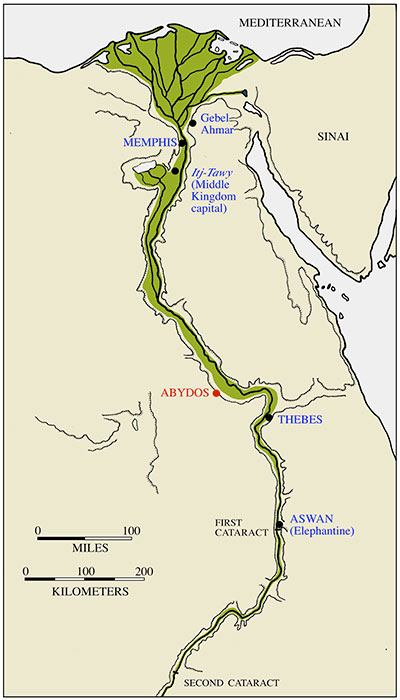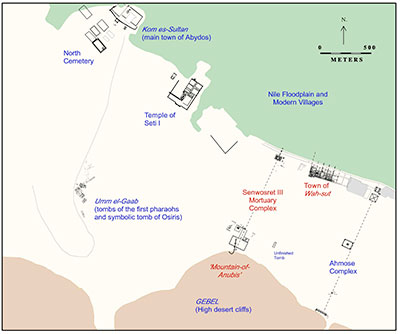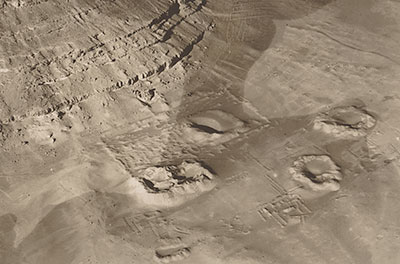Abydos in southern Egypt is one of the great sites of ancient Egyptian civilization. At the dawn of Egyptian history, ca. 3000–2800 BCE, Abydos was the burial place of Egypt’s first pharaohs. Subsequently the site became the primary cult center for veneration of Osiris, god of the netherworld. The archaeology of Abydos spans over five millennia and represents the full timeframe of ancient Egypt from its earliest origins to its decline in late antiquity.
In 1967, David O’Connor, then Curator of the Museum’s Egyptian Section, initiated the Pennsylvania-Yale Expedition to Abydos. A significant set of artifacts from the Museum’s work at North Abydos came to Philadelphia in the late 1960s, representing some of the last Egyptian material to enter the collection. Some 3,000 artifacts from Abydos—only a handful currently on display—are included in the Egyptian Section’s overall collection of more than 45,000 artifacts. In this issue of Expedition we examine both our ongoing research at South Abydos as well as the Abydos collection in the Penn Museum.
2014 represents the 20th anniversary of the inception of the Museum’s current research program at the mortuary complex of Senwosret III at South Abydos. In 1994, for my Ph.D. research, I began excavations on the temple and town site associated with the cult of the 12th Dynasty pharaoh Senwosret III. This remarkable site, a kind of southern suburb to the center of Abydos, had seen a brief period of excavation between 1899 and 1903 but offered huge potential for the study of Abydos during the important phase of the Middle Kingdom (Dynasties 11–13, ca. 2050–1650 BCE). The excavations at South Abydos have rewarded us with many significant discoveries over the years.

The site includes royal tombs, a temple, extensive urban remains, non-royal cemeteries, and other elements yet to be defined. We have identified the site’s ancient name: Enduring-are-the-Places-of-Khakaure-true-of-voicein-Abydos. The symbolic anchor of this site is a massive subterranean tomb—likely the burial place of Senwosret III—situated beneath a 700-foot desert peak anciently named the Mountain-of-Anubis. Gradually we have been peeling back the sands of South Abydos to understand this unique place, which offers an unparalleled window into Egyptian culture and society 4,000 years ago.

(between 1899–1902), work of the Egypt Exploration Fund defined some of the main elements of the Senwosret III complex. Today the site is yielding an unexpectedly rich volume of information on the culture and society of Egypt’s Middle Kingdom. In this issue of Expedition we examine some of the recent work in the town site and cemeteries of South Abydos as discussed in articles by myself, Ph.D. student Kevin Cahail, and Penn graduate Dawn McCormack. This includes an update on the excavation program inside the subterranean tomb of Senwosret III.
In this issue we also highlight the outstanding collection of archaeological material from Abydos that today is housed in the Museum. Most of it has never been on display but it includes treasures from the tombs of Egypt’s first pharaohs and many other artifacts of note. Molly Gleeson describes one such object, a fragmentary painted co:n of the Middle Kingdom (ca. 2000–1700 BCE), which is currently being conserved. Jennifer Houser Wegner discusses the early collection at the Museum, while David O’Connor, Curator Emeritus, presents a retrospective on the material that came to Philadelphia in the late 1960s.

Josef Wegner, Ph.D. Associate curator, Egyptian Section
